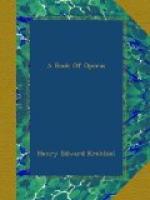Mention has been made of the fact that Beethoven wrote four overtures for his opera. Three of these are known as Overtures “Leonore No. 1,” “Leonore No. 2,” and “Leonore No. 3”—“Leonore” being the title by which the opera was known at the unfortunate first performance. The composer was never contented with the change to “Fidelio” which was made, because of the identity of the story with the “Leonore” operas, of Gaveaux and Paer. Much confusion has existed in the books (and still exists, for that matter) touching the order in which the four overtures were composed. The early biographers were mistaken on that point, and the blunder was perpetuated by the numbering when the scores were published. The true “Leonore No. 1,” is the overture known in the concert-room, where it is occasionally heard, as “Leonore No. 2.” This was the original overture to the opera, and was performed at the three representations in 1805. The overture called “Leonore No. 3” was the result of the revision undertaken by Beethoven and his friends after the failure. In May, 1807, the German opera at Prague was established and “Fidelio” selected as one of the works to be given. Evidently Beethoven was dissatisfied both with the original overture and its revision, for he wrote a new one, in which he retained the theme from Florestan’s air, but none of the other themes used in Nos. 2 and 3. The performances at Prague did not take place, and nobody knows what became of the autograph score of the overture. When Beethoven’s effects were sold at auction after his death, Tobias Haslinger bought a parcel of dances and other things in manuscript. Among them were a score and parts of an overture in C, not in Beethoven’s handwriting, but containing corrections made by him. It bore no date, and on a violin part Beethoven had written first “Overtura, Violino Imo.” Later he had added words in red crayon to make it read, “Overtura in C, charakteristische Overture, Violino Imo.” On February 7, 1828, the composition was played at a concert in Vienna, but notwithstanding the reminiscence of Florestan’s air, it does not seem to have been associated with the opera, either by Haslinger or the critics. Before 1832, when Haslinger published the overture as Op. 138, however, it had been identified, and, not unnaturally, the conclusion was jumped at that it was the original overture. That known as “Leonore No. 2” having been withdrawn for revision by Beethoven himself, was not heard of till 1840, when it was performed at a Gewandhaus concert in Leipsic. For the revival of the opera in 1814 Beethoven composed the overture in E major, now called the “Fidelio” overture, and generally played as an introduction to the opera, the much greater “Leonore No. 3” being played either between the acts, or, as by Mahler in New York and Vienna, between the two scenes of the second act, where it may be said it distinctly has the effect of an anticlimax. The thematic material of the “Leonore” overtures Nos. 2 and 3 being practically the same,




